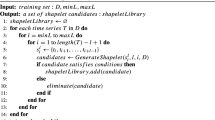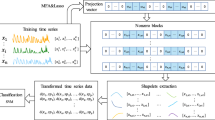Abstract
Compared to the full-length methods for time series classification, shapelet-based methods acquire better interpretation, higher efficiency and precision since shapelets are discriminative features that well represent a time series. However, because of the large number of shapelets candidates, determining how to filter out shapelets with higher discriminability remains a challenge. In this paper, we propose a two-phase shapelets learning filtering framework for time series classification. Time series is first split into groups using the extreme key points, and local linear discriminant analysis with sparse group lasso regularizer is proposed to find projection vector. Then, a two-phase filtering framework is established to measure the sparsity of groups in order to quickly find the key group, where l2-norm is introduced in phase-1 and group sparsity degree is defined in phase-2 to filter sparse groups. Following that, only a few groups are used to extract shapelets and classify them, reducing the number of shapelets significantly. Finally, the group with the highest classification accuracy, i.e., the key group, is determined accurately. Extensive experiments on 28 time series datasets show that, when compared to other state-of-the-art shapelet-based classification methods, our proposed method achieves significant improvement and a competitive time cost.







Similar content being viewed by others
References
Ahmed T, Singh D (2020) Probability density functions based classification of modis ndvi time series data and monitoring of vegetation growth cycle. Adv Space Res 66(4):873– 886
Al-Hadeethi H, Abdulla S, Diykh M, Deo R C, Green JH (2020) Adaptive boost ls-svm classification approach for time-series signal classification in epileptic seizure diagnosis applications. Expert Syst Appl 161:113676
Belkin M, Niyogi P (2003) Laplacian eigenmaps for dimensionality reduction and data representation. Neural Comput 15(6):1373–1396
Chang KW, Deka B, Hwu WMW, Roth D (2012) Efficient pattern-based time series classification on gpu. In: 2012 IEEE 12th International conference on data mining. IEEE, pp 131– 140
Chen J, Dai G, Zhang N (2020) An application of sparse-group lasso regularization to equity portfolio optimization and sector selection. Ann Oper Res 284(1):243–262
Dau HA, Bagnall A, Kamgar K, Yeh CCM, Zhu Y, Gharghabi S, Ratanamahatana CA, Keogh E (2019) The ucr time series archive. IEEE/CAA J Automatica Sinica 6(6):1293–1305
Ding H, Trajcevski G, Scheuermann P, Wang X, Keogh E (2008) Querying and mining of time series data: experimental comparison of representations and distance measures. Proc VLDB Endowment 1 (2):1542–1552
Fisher RA (1936) The use of multiple measurements in taxonomic problems. Annals Eugenics 7 (2):179–188
Friedman JH (1989) Regularized discriminant analysis. J Amer Statal Association 84(405):165–175
Gordon D, Hendler D, Rokach L (2012) Fast randomized model generation for shapelet-based time series classification. arXiv:12095038
Gordon D, Hendler D, Rokach L (2015) Fast and space-efficient shapelets-based time-series classification. Intell Data Anal 19(5):953–981
Grabocka J, Schilling N, Wistuba M, Schmidt-Thieme L (2014) Learning time-series shapelets. In: Proceedings of the 20th ACM SIGKDD international conference on Knowledge discovery and data mining, pp 392–401
Grabocka J, Wistuba M, Schmidt-Thieme L (2015) Scalable discovery of time-series shapelets. arXiv:150303238
He X, Niyogi P (2004) Locality preserving projections. In: Advances in neural information processing systems, pp 153– 160
Hills J, Lines J, Baranauskas E, Mapp J, Bagnall A (2014) Classification of time series by shapelet transformation. Data Min Knowl Disc 28(4):851–881
Hou L, Kwok JT, Zurada JM (2016) Efficient learning of timeseries shapelets. In: Proceedings of the thirtieth AAAI conference on artificial intelligence, pp 1209–1215
Huang C, Wu X, Zhang X, Lin S, Chawla NV (2019) Deep prototypical networks for imbalanced time series classification under data scarcity. In: Proceedings of the 28th ACM international conference on information and knowledge management, pp 2141–2144
Karampatziakis N, Mineiro P (2014) Discriminative features via generalized eigenvectors. In: International conference on machine learning, pp 494–502
Kourou K, Rigas G, Papaloukas C, Mitsis M, Fotiadis DI (2020) Cancer classification from time series microarray data through regulatory dynamic bayesian networks. Comput Biol Med 103577:116
Li L, Chang D, Han L, Zhang X, Zaia J, Wan XF (2020) Multi-task learning sparse group lasso: a method for quantifying antigenicity of influenza a (h1n1) virus using mutations and variations in glycosylation of hemagglutinin. BMC Bioinformatics 21:1–22
Liang Z, Wang H (2021) Efficient class-specific shapelets learning for interpretable time series classification. Inf Sci 570:428– 450
Lin J, Keogh E, Wei L, Lonardi S (2007) Experiencing sax: a novel symbolic representation of time series. Data Mining Knowl Discover 15(2):107–144
Lines J, Davis LM, Hills J, Bagnall A (2012) A shapelet transform for time series classification. In: Proceedings of the 18th ACM SIGKDD international conference on Knowledge discovery and data mining, pp 289–297
Mueen A, Keogh E, Young N (2011) Logical-shapelets: an expressive primitive for time series classification. In: Proceedings of the 17th ACM SIGKDD international conference on knowledge discovery and data mining, pp 1154–1162
Park H, Jung JY (2020) Sax-arm: deviant event pattern discovery from multivariate time series using symbolic aggregate approximation and association rule mining. Expert Syst Appl 141:112950
Puk KM, Wang S, Rosenberger J, Gandy KC, Harris HN, Peng YB, Nordberg A, Lehmann P, Tommerdahl J, Chiao JC (2019) Emotion recognition and analysis using admm-based sparse group lasso. IEEE Trans Affect Comput 13(1):199–210
Qian B, Xiao Y, Zheng Z, Zhou M, Zhuang W, Li S, Ma Q (2020) Dynamic multi-scale convolutional neural network for time series classification. IEEE Access 8:109732–109746
Rahulamathavan Y, Phan RCW, Chambers JA, Parish DJ (2012) Facial expression recognition in the encrypted domain based on local fisher discriminant analysis. IEEE Trans Affect Comput 4(1):83–92
Rakthanmanon T, Keogh E (2013) Fast shapelets: a scalable algorithm for discovering time series shapelets. In: Proceedings of the 2013 SIAM international conference on data mining, SIAM, pp 668-676
Sart D, Mueen A, Najjar W, Keogh E, Niennattrakul V (2010) Accelerating dynamic time warping subsequence search with gpus and fpgas. In: 2010 IEEE international conference on data mining. IEEE, pp 1001–1006
Shi Z, Hu J (2017) A kernel approach to implementation of local linear discriminant analysis for face recognition. IEEJ Trans Electr Electron Eng 12(1):62–70
Simon N, Friedman J, Hastie T, Tibshirani R (2013) A sparse-group lasso. J Comput Graph Stat 22(2):231–245
Sugiyama M (2006) Local fisher discriminant analysis for supervised dimensionality reduction. In: Proceedings of the 23rd international conference on machine learning, pp 905– 912
Tibshirani R (1996) Regression shrinkage and selection via the lasso. J Royal Stat Society Series B (Methodological) 58(1):267–288
Tibshirani R, Saunders M, Rosset S, Zhu J, Knight K (2005) Sparsity and smoothness via the fused lasso. J Royal Stat Society Series B (Stat Methodology) 67(1):91–108
Ujan S, Navidi N, Landry Jr R et al (2020) Hierarchical classification method for radio frequency interference recognition and characterization in satcom. Appl Sci 10(13):4608
Wang H, Wu J, Zhang P, Chen Y (2018) Learning shapelet patterns from network-based time series. IEEE Trans Industr Inform 15(7):3864–3876
Wang Y, Emonet R, Fromont E, Malinowski S, Menager E, Mosser L, Tavenard R (2019) Learning interpretable shapelets for time series classification through adversarial regularization. arXiv:190600917
Wang Z, Ruan Q, An G (2015) Face recognition using double sparse local fisher discriminant analysis. Math Probl Eng:2015
Wistuba M, Grabocka J, Schmidt-Thieme L (2015) Ultra-fast shapelets for time series classification. arXiv:150305018
Yahyaoui H, Al-Daihani R (2019) A novel trend based sax reduction technique for time series. Expert Syst Appl 130:113–123
Ye L, Keogh E (2009) Time series shapelets: a new primitive for data mining. In: Proceedings of the 15th ACM SIGKDD international conference on knowledge discovery and data mining, pp 947–956
Yeung JFA, Zk W, Chan KY, Lau HY, Yiu KFC (2020) Jump detection in financial time series using machine learning algorithms. Soft Comput 24(3):1789–1801
Yu B, Li S, Qiu W, Wang M, Du J, Zhang Y, Chen X (2018) Prediction of subcellular location of apoptosis proteins by incorporating psepssm and dcca coefficient based on lfda dimensionality reduction. BMC genomics 19(1):1–17
Yuan M, Lin Y (2006) Model selection and estimation in regression with grouped variables. J Royal Stat Society Series B (Stat Methodol) 68(1):49–67
Zaatour R, Bouzidi S, Zagrouba E (2019) Class-adapted local fisher discriminant analysis to reduce highly-dimensioned data on commodity hardware: application to hyperspectral images. Multimed Tools Appl 78(12):17113–17134
Zakaria J, Mueen A, Keogh E, Young N (2016) Accelerating the discovery of unsupervised-shapelets. Data Mining Knowl Discover 30(1):243–281
Zhang Z, Zhang H, Wen Y, Zhang Y, Yuan X (2018) Discriminative extraction of features from time series. Neurocomputing 275:2317–2328
Zhuo L, Cheng B, Zhang J (2014) A comparative study of dimensionality reduction methods for large-scale image retrieval. Neurocomputing 141:202–210
Acknowledgements
We thank the reviewers for their valuable comments. This work is supported by the Fundamental Research Funds for the Central Universities, China under Grant 2020ZY216 and 2021III030JC.
Author information
Authors and Affiliations
Corresponding author
Ethics declarations
Conflict of Interests
The authors declare that they have no conflict of interest.
Additional information
Publisher’s note
Springer Nature remains neutral with regard to jurisdictional claims in published maps and institutional affiliations.
Rights and permissions
Springer Nature or its licensor holds exclusive rights to this article under a publishing agreement with the author(s) or other rightsholder(s); author self-archiving of the accepted manuscript version of this article is solely governed by the terms of such publishing agreement and applicable law.
About this article
Cite this article
Li, C., Wan, Y., Zhang, W. et al. A two-phase filtering of discriminative shapelets learning for time series classification. Appl Intell 53, 13815–13833 (2023). https://doi.org/10.1007/s10489-022-04043-9
Accepted:
Published:
Issue Date:
DOI: https://doi.org/10.1007/s10489-022-04043-9




